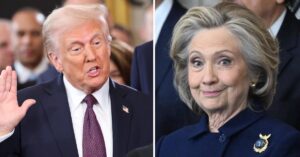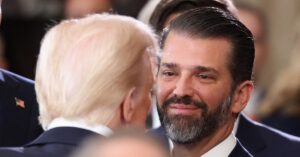Support for Hillary Clinton’s Laughter at Inauguration Goes Viral
Following the circulation of a video clip showing Hillary Clinton laughing during Donald Trump’s inauguration, social media users expressed their support for her reaction. The video sparked a wave of comments, with some users applauding her lighthearted moment amidst the solemn occasion.
One Twitter user commented, “If only it were a joke,” highlighting the tense atmosphere of the event. Another user responded, “Let her have her little moment,” showing empathy towards Clinton’s reaction.
Adding to the conversation, a third user remarked, “I loved watching her and Bill [Clinton] throughout this speech. And she didn’t hold back,” appreciating the candidness of the Clintons during the event. Another user agreed, “I’d have laughed if I’d been there and not just at that, there was much to laugh at,” indicating that there were several moments during the inauguration that elicited amusement.
The online support for Hillary Clinton’s laughter reflects the diverse reactions to political events and the ways in which individuals interpret and respond to public displays of emotion.
Understanding the Context of Hillary Clinton’s Laughter
It is essential to delve deeper into the context surrounding Hillary Clinton’s laughter during Donald Trump’s inauguration to grasp the significance of her reaction. As a prominent political figure, Clinton’s actions are often scrutinized and interpreted in various ways by the public and media.
During the inauguration ceremony, Clinton’s laughter could be seen as a coping mechanism or a moment of levity in an otherwise intense and serious atmosphere. The transition of power from one administration to another can evoke a range of emotions, and Clinton’s laughter may have been her way of processing the events unfolding before her.
Additionally, the dynamics between Clinton and Trump, both former presidential candidates with a history of political rivalry, could have influenced her emotional response during the inauguration. The complexities of their relationship and the high-stakes nature of the event may have contributed to Clinton’s display of laughter.
By considering the broader context of the inauguration and the dynamics between key political figures, we can gain a deeper understanding of the motivations behind Clinton’s laughter and the reactions it elicited from the public.
Exploring Public Reactions to Hillary Clinton’s Laughter
The public reactions to Hillary Clinton’s laughter at Donald Trump’s inauguration offer insights into how individuals perceive and interpret political gestures and expressions. Social media platforms serve as virtual arenas where users engage in discussions, debates, and reflections on current events, including the behavior of political figures.
Supportive comments towards Clinton’s laughter suggest a willingness to empathize with her as a human being navigating complex political landscapes. By acknowledging the emotional responses of public figures, users demonstrate a more nuanced understanding of the pressures and challenges faced by individuals in positions of power.
Furthermore, the diverse reactions to Clinton’s laughter highlight the subjective nature of interpreting non-verbal communication in political contexts. While some users viewed her laughter as a moment of authenticity and relatability, others may have perceived it differently based on their own biases and perspectives.
By examining the spectrum of reactions to Clinton’s laughter, we gain valuable insights into the complexities of public opinion, empathy, and interpretation in the realm of politics and social media.
Implications of Hillary Clinton’s Laughter in Political Discourse
The discussion surrounding Hillary Clinton’s laughter at Donald Trump’s inauguration raises broader questions about the role of emotion in political discourse and public perception. Emotions play a significant role in shaping political narratives, influencing public opinion, and humanizing political figures.
Clinton’s laughter can be viewed as a moment of vulnerability and authenticity in a highly scripted and formal event. By expressing her emotions openly, she defied traditional expectations of political decorum and revealed a more human side to her public persona.
Moreover, the public reactions to Clinton’s laughter underscore the power of empathy and understanding in fostering meaningful dialogue and engagement in political discourse. By recognizing and acknowledging the emotions of political figures, individuals can cultivate a more compassionate and nuanced approach to public affairs.
In conclusion, the viral response to Hillary Clinton’s laughter at Donald Trump’s inauguration serves as a reminder of the complexities of human emotion, political communication, and public perception. By exploring the context, reactions, and implications of this moment, we gain valuable insights into the intersection of politics, emotion, and social media in contemporary society.
Catch Up on the Latest News and Trending Topics Now!







